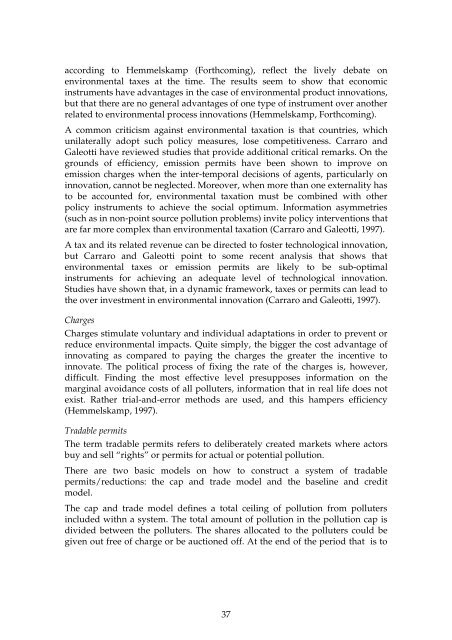Drivers of environmental innovation - Vinnova
Drivers of environmental innovation - Vinnova
Drivers of environmental innovation - Vinnova
Create successful ePaper yourself
Turn your PDF publications into a flip-book with our unique Google optimized e-Paper software.
according to Hemmelskamp (Forthcoming), reflect the lively debate on<br />
<strong>environmental</strong> taxes at the time. The results seem to show that economic<br />
instruments have advantages in the case <strong>of</strong> <strong>environmental</strong> product <strong>innovation</strong>s,<br />
but that there are no general advantages <strong>of</strong> one type <strong>of</strong> instrument over another<br />
related to <strong>environmental</strong> process <strong>innovation</strong>s (Hemmelskamp, Forthcoming).<br />
A common criticism against <strong>environmental</strong> taxation is that countries, which<br />
unilaterally adopt such policy measures, lose competitiveness. Carraro and<br />
Galeotti have reviewed studies that provide additional critical remarks. On the<br />
grounds <strong>of</strong> efficiency, emission permits have been shown to improve on<br />
emission charges when the inter-temporal decisions <strong>of</strong> agents, particularly on<br />
<strong>innovation</strong>, cannot be neglected. Moreover, when more than one externality has<br />
to be accounted for, <strong>environmental</strong> taxation must be combined with other<br />
policy instruments to achieve the social optimum. Information asymmetries<br />
(such as in non-point source pollution problems) invite policy interventions that<br />
are far more complex than <strong>environmental</strong> taxation (Carraro and Galeotti, 1997).<br />
A tax and its related revenue can be directed to foster technological <strong>innovation</strong>,<br />
but Carraro and Galeotti point to some recent analysis that shows that<br />
<strong>environmental</strong> taxes or emission permits are likely to be sub-optimal<br />
instruments for achieving an adequate level <strong>of</strong> technological <strong>innovation</strong>.<br />
Studies have shown that, in a dynamic framework, taxes or permits can lead to<br />
the over investment in <strong>environmental</strong> <strong>innovation</strong> (Carraro and Galeotti, 1997).<br />
Charges<br />
Charges stimulate voluntary and individual adaptations in order to prevent or<br />
reduce <strong>environmental</strong> impacts. Quite simply, the bigger the cost advantage <strong>of</strong><br />
innovating as compared to paying the charges the greater the incentive to<br />
innovate. The political process <strong>of</strong> fixing the rate <strong>of</strong> the charges is, however,<br />
difficult. Finding the most effective level presupposes information on the<br />
marginal avoidance costs <strong>of</strong> all polluters, information that in real life does not<br />
exist. Rather trial-and-error methods are used, and this hampers efficiency<br />
(Hemmelskamp, 1997).<br />
Tradable permits<br />
The term tradable permits refers to deliberately created markets where actors<br />
buy and sell “rights” or permits for actual or potential pollution.<br />
There are two basic models on how to construct a system <strong>of</strong> tradable<br />
permits/reductions: the cap and trade model and the baseline and credit<br />
model.<br />
The cap and trade model defines a total ceiling <strong>of</strong> pollution from polluters<br />
included withn a system. The total amount <strong>of</strong> pollution in the pollution cap is<br />
divided between the polluters. The shares allocated to the polluters could be<br />
given out free <strong>of</strong> charge or be auctioned <strong>of</strong>f. At the end <strong>of</strong> the period that is to<br />
37

















